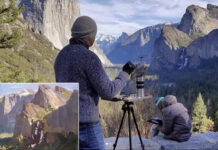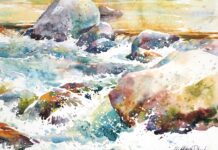Plein Air Painting and Color Mixing for Beginners >
One of the benefits of attending the annual Plein Air Live virtual art conference is that it’s so full of tips, techniques, and even conversations about what it means to be a plein air painter. The next one is March 6-8, 2024, with an Essential Techniques day on March 5. See you there!
The following is from the “Every Plein Air Question Answered” session led by Eric Rhoads.

Color Mixing and Palettes for Beginners
Q: Do I use all the colors I use in the studio when I’m painting outside?
A: Well, it depends on how many colors you use in the studio, doesn’t it? I think that as an early-stage painter, the best possible thing to do is to learn how to paint with three colors: a yellow, a red, and a blue. You can use color mixing techniques to create essentially any color from those three and you get this spectacular color harmony because they’re all in each other, so to speak. The minute you add more and more colors to your palette, it complicates the color harmony issues.
Now, I don’t know if you’ve ever seen my studio – I have 1,000 tubes of paint, but I have a standard number of colors that I always use no matter what, when I paint in the studio or en plein air. I always use those same colors, and I pretty much standardized them. I always put them in the exact same order on my palette, because it’s like a piano keyboard; you just automatically instinctively know where they are.
In my case, I know my whites are in this corner, and my blacks are in this corner. My blues are over here, my reds over here, my yellows are over here.
There are a lot of different approaches. Some people like to have a chromatic palette, so it’s kind of a rainbow. Some people like to have their warms and their cools separated. It doesn’t really matter – what matters is that you get used to it. I recommend stabilizing on some colors.
Now the most common thing that I’ve seen is that most plein air painters use a warm and a cool of each color. So they have a warm and a cool version: a warm and cool red, a warm and cool yellow, and a warm and cool blue.
Most people don’t use pre-mixed greens; most of them just mix their greens as well as their blacks. So again, it doesn’t matter but stick to it.
I used to chase color all the time. I’d walk into a store and buy 30 tubes of paint because I would “have to have” each color. Every time I did that, I’d screw up my palette because it changed my color mixtures. (To be honest, I still do it because I love colors and I’m always changing things, trying to figure out what’s better, and what’s next. But that’s one approach to it.)
So I would start out with three colors and white. Painting is hard enough, and mixing colors is hard enough, so get used to that. Then, if you want to, add in some more colors, but get stabilized on basic color mixing first.
Related Article > PleinAir Podcast 148: Mark Boedges on Painting Greens and More





One of my teachers showed me how to read the formulas on paint tubes (most brands show the various pigment colors used to make that particular color; or else you can find the info online at the manufacturer’s website). I discovered that many of my favorite or “cool” convenience colors could easily be made with some of the old standards. So now I always check that formula before deciding I just have to have that new tube of paint.
Brilliant! I wish I had started that years ago. Maybe it’s not too late…
I took a workshop many years ago with Morris Shubin. One exercise was to make 50 greens without using green. I did. And have not had tube green on my palette since.
Prior to that, even when using the most “natural” tube green and mixing in other colors, my entire painting still looked the same. Always try what the instructor tells you!